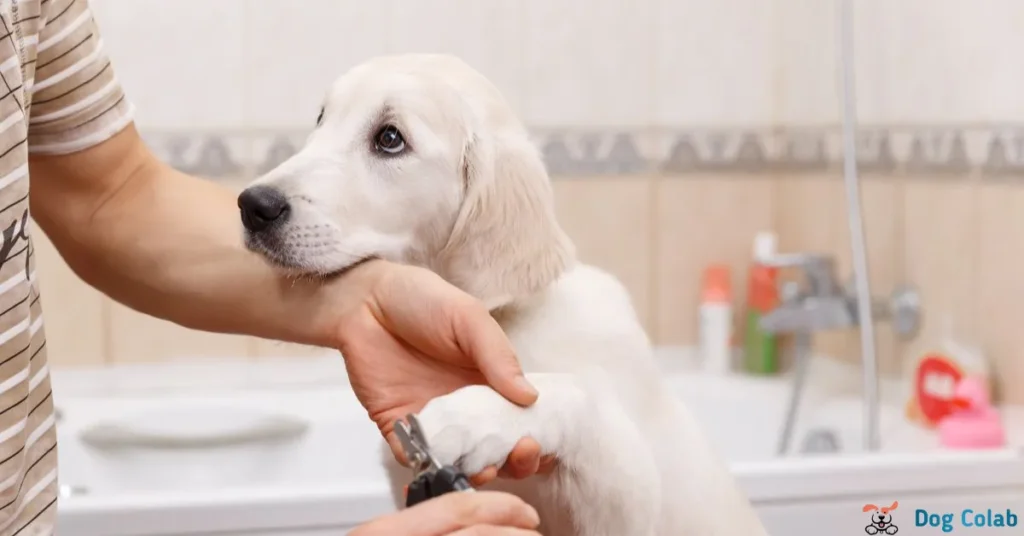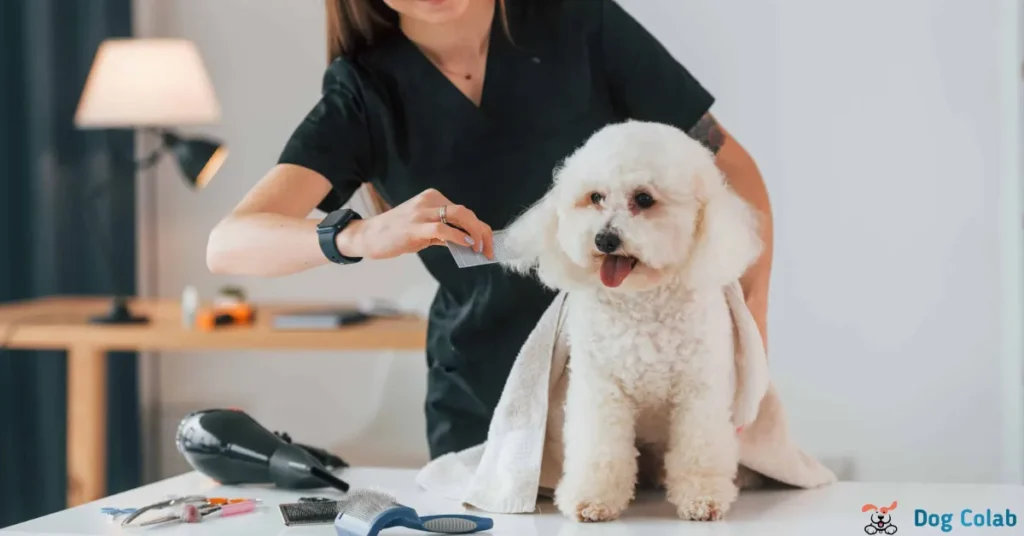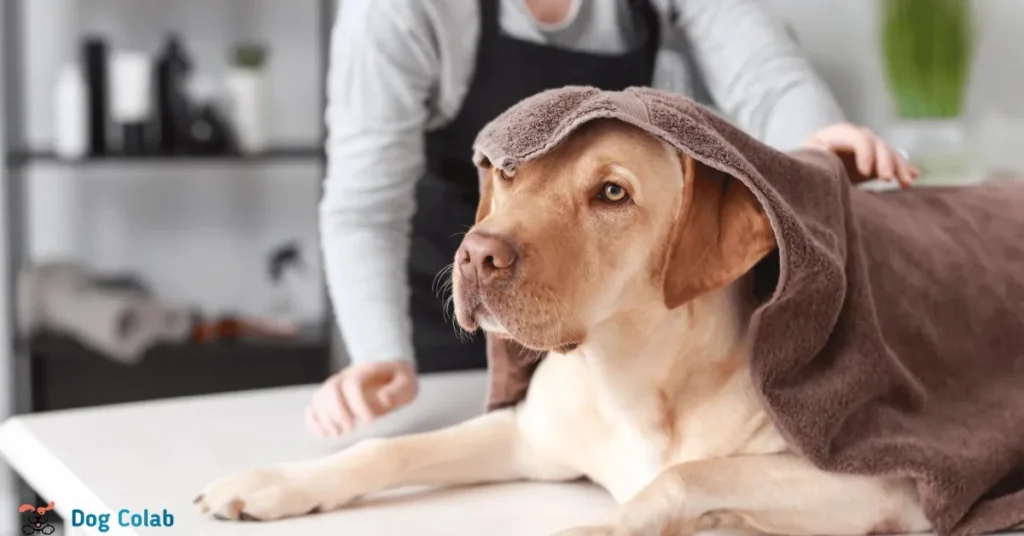A dog’s grooming is an important part of his care. It helps keep them clean and healthy. However, after a grooming session, many dog owners notice that their dogs can sometimes act strangely or exhibit unusual behaviors.
Well, why do dogs act weird after grooming? Dogs may act weird after grooming due to the unfamiliar scents, sensations, and stress of the grooming process, which can temporarily disrupt their usual behavior and routines.
In this blog post, we will explore the reasons why do dogs act weird after grooming and how long do dogs act weird after grooming.
Why Is My Dog Acting Weird After Grooming?
Dogs may act “weird” or exhibit unusual behavior after grooming for several reasons. Here are some common reasons why do dogs act weird after grooming.
1. Sensory Changes
Grooming often involves trimming, shaving, or cutting a dog’s fur. This can make them feel lighter, expose their skin to new sensations, and alter their sensory perception. The dog may react to these changes by appearing restless or unsettled.
2. New Scent
Grooming products, such as shampoos and conditioners, can leave a new scent on the dog’s coat. This scent might be unfamiliar to the dog, and they may spend time sniffing and trying to get used to it.
3. Anxiety or Stress
One of the most common reasons for how long will my dog act weird after grooming is due to anxiety and stress. Grooming involves various activities such as bathing, nail trimming, brushing, and the use of grooming tools like clippers and scissors. Some dogs find these activities uncomfortable or frightening, which can lead to anxiety. As a result, they may act weirdly or exhibit unusual behaviors like restlessness, hiding, or excessive panting.
4. Physical Discomfort
Grooming can sometimes lead to physical discomfort, particularly if your dog has sensitive skin or certain skin conditions. Bathing or brushing may temporarily irritate their skin, causing itching or mild discomfort.

In response to this discomfort, dogs may engage in unusual behaviors such as excessive scratching, licking, or rolling on the ground.
5. Different Appearance
After grooming, a dog’s appearance may change significantly. Some dogs might react to their reflection or their owner’s reactions to their new look. This can result in curiosity or confusion.
6. Overstimulation
The grooming process can be overstimulating for some dogs, with all the handling, brushing, and other sensory input. This can leave them feeling hyperactive or anxious after the grooming session.
7. Release of Energy
Some dogs might have pent-up energy they couldn’t expend during the grooming session. Once they are out of the grooming environment, they might exhibit playful or excited behavior.
8. Traumatic Experiences
Not all grooming experiences are positive for dogs. If your dog had a traumatic grooming experience in the past, they may exhibit signs of fear, anxiety, or even aggression during or after grooming. Traumatic experiences can have a lasting impact on a dog’s behavior, and it might take a significant amount of time and positive reinforcement to help them overcome their fear or anxiety.
Read More:- Why do dogs look away from you.
How Long Do Dogs Act Weird After Grooming?
The duration of a dog acting strange after grooming varies from one pet to another and depends on several factors.

- Sensitivity of the Dog: Some dogs are more sensitive or anxious, and they may exhibit signs of stress or discomfort for a longer period after grooming. It may take them several hours or even a day to return to their normal behavior.
- Type of Grooming: The type of grooming involved can also impact how long a dog acts “weird.” For example, a simple bath and brushing session may result in less disruption to their behavior than a more extensive dog grooming procedure involving haircuts, nail trims, or ear cleaning.
- Previous Experience: A dog’s past grooming experiences can influence their behavior. If they’ve had negative experiences in the past, they may take longer to adjust and may act “weird” for a more extended period.
- Environmental Factors: The environment in which the grooming takes place can affect a dog’s behavior. A noisy or busy grooming salon may make some dogs more anxious, while a quiet and familiar setting might result in a quicker return to normal behavior.
- Individual Personality: Dogs have distinct personalities, and some may be more resilient and adaptable, while others are more sensitive. Understanding your dog’s personality and how they react to different situations is important.
Generally, many dogs may act a bit “weird” immediately after grooming due to the unfamiliar smells, sensations, and the overall experience. They might appear anxious, hyperactive, or disoriented for a few hours. However, by the next day or within a day or two, most dogs tend to return to their usual behavior.
Is It Normal For Dogs To Act Weird After Grooming?
Yes, it’s normal for dogs to act a bit differently after grooming. This behavior typically subsides as they become accustomed to their freshly groomed state.
Read More:- Why do dogs shake when you pet them.
Tips To Help Your Dog To Adjust After Grooming
Grooming can be a stressful experience for some dogs, especially if they are not used to it. Here are some tips to help your dog adjust and feel more comfortable after grooming.

- Positive Reinforcement: Always reward your dog with treats, praise, and affection after grooming. This will create a positive association with the experience.
- Gradual Introduction: If your dog is not used to grooming, introduce them to it gradually. Start with short sessions and increase the duration as your dog becomes more comfortable.
- Choose a Reputable Groomer: If you’re taking your dog to a professional groomer, make sure you choose a reputable one. A skilled and gentle groomer can make a big difference in your dog’s grooming experience.
- Regular Grooming: Regular grooming sessions can help your dog become more accustomed to the process. Brushing and combing your dog at home can also help reduce anxiety during grooming sessions.
- Comfortable Environment: Create a comfortable environment for your dog during and after grooming. Use a non-slip mat on the grooming table and keep the room at a comfortable temperature.
- Gentle Handling: Be gentle when handling your dog during grooming. Speak in a soothing voice and use soft, slow movements to avoid startling or scaring them.
- Frequent Breaks: During grooming, take frequent breaks to give your dog a chance to relax and get used to the process. This is especially important for dogs with anxiety.
- Check for Sensitivities: Some dogs may have sensitive areas, so be gentle when grooming these spots. Check for any cuts, irritations, or signs of discomfort during and after grooming.
- Watch for Signs of Stress: Watch how your dog behaves. Signs of stress can include panting, drooling, trembling, or trying to escape. If your dog seems overly stressed, take a break and try to make them more comfortable.
- Post-Grooming Play: After grooming, engage in some playtime or a short walk to help your dog burn off any excess energy and release built-up tension.
- Regular Handling: Get your dog used to being handled on a regular basis, not just during grooming sessions. This will help reduce their anxiety and make grooming less stressful.
- Be Patient: Dogs may take time to adjust to grooming. Be patient and understanding, and avoid scolding or punishing them if they’re anxious.
How To Relieve Dog Itching After Grooming?
Relieving dog itching after grooming is important to ensure your furry friend is comfortable and happy. Here are some steps you can take to help alleviate itching in your dog.

- Check for Irritants: First, check to see if there are any obvious irritants on your dog’s skin or in their coat. It’s possible that residual shampoo, conditioner, or grooming products are causing the itching. If you suspect this, consider giving your dog a gentle rinse with lukewarm water to remove any residues.
- Use Hypoallergenic Products: Make sure you’re using hypoallergenic grooming products specifically designed for dogs with sensitive skin. These products are less likely to cause irritation.
- Bathe with Cool Water: If your dog is experiencing itching after grooming, a cool water bath can help soothe their skin. Make sure the water isn’t too cold, and use a gentle dog shampoo. Avoid using hot water, as it can exacerbate the itching.
- Oatmeal Bath: An oatmeal bath can be soothing for itchy skin. You can find oatmeal dog shampoos, or you can make your own by blending plain, uncooked oatmeal and adding it to the bathwater.
- Rinse Thoroughly: Be sure to rinse your dog thoroughly after bathing to remove all traces of shampoo. Leftover residue can cause itching.
- Moisturize: Use a hypoallergenic dog conditioner or moisturizer after bathing. This can help keep your dog’s skin hydrated and reduce itching. Look for products that contain soothing ingredients like aloe vera or chamomile.
- Brush Regularly: Regular brushing helps remove loose fur and prevents matting, which can be uncomfortable for your dog.
- Avoid Over-Bathing: Dogs don’t need frequent baths unless they get particularly dirty or develop skin issues. Over-bathing can strip their skin of natural oils, leading to dryness and itching. Follow a recommended bathing schedule for your dog’s breed and lifestyle.
- Consult a Vet: If your dog’s itching persists or worsens, it’s a good idea to consult with your veterinarian. Itching can be caused by underlying skin conditions, allergies, or other health issues that may require medical attention.
- Consider Allergies: Allergies, both food and environmental, can lead to itching. Discuss any potential allergies with your vet, who can recommend allergy testing or changes in your dog’s diet.
- Flea Prevention: Fleas are a common cause of itching in dogs. Ensure your dog is on a regular flea prevention regimen, especially if they spend time outdoors or interact with other animals.
- Keep Nails Trimmed: Sometimes, itching can result from sharp or overgrown nails scratching the skin. Keep your dog’s nails trimmed regularly to prevent this.
Conclusion “How Long Do Dogs Act Weird After Grooming”
Dogs often exhibit weird behavior after grooming due to the unfamiliar sensations, anxiety, and changes in their scent and appearance.
The duration of a dog acting weird after grooming depends on various factors, including the dog’s individual temperament, grooming experience, and the specific procedures performed during the grooming session. Most dogs tend to return to their usual selves within a day or two.
NOTE:- Further information can be found by clicking this link.
FAQs
1. Why is my dog shaking after grooming?
Your dog may shake after grooming due to anxiety, excitement, or as a way to release pent-up stress. It can also be a reaction to the grooming process, such as being wet or experiencing unfamiliar sensations.
2. Why is my dog so tired after grooming?
Grooming can be physically and mentally exhausting for dogs due to the stress, handling, and novelty of the experience. It may also involve physical activities and the anxiety of being in a new environment.
3. Why is my dog scooting after grooming?
Scooting after grooming may indicate discomfort or irritation in your dog’s anal area. It could be due to residual shampoo, clipped fur, or anal gland issues. For a proper diagnosis, consult your veterinarian.
4. Why is my dog depressed after grooming?
Your dog may appear depressed after grooming due to the stress or anxiety caused by the grooming process. It’s a new and potentially uncomfortable experience for them. Give them some time to adjust and offer comfort.
5. Do dogs understand they are being groomed?
Dogs may not fully understand the concept of grooming as humans do, but they can learn to associate the grooming process with care and affection from their owners, which can make it a positive experience for them.

